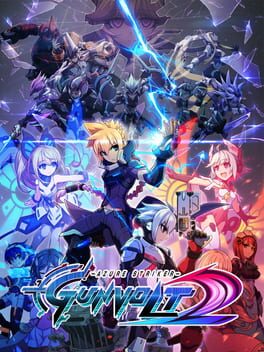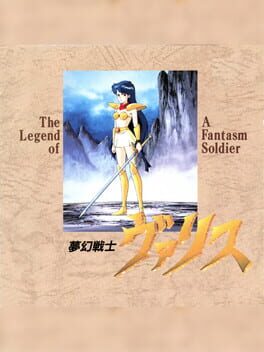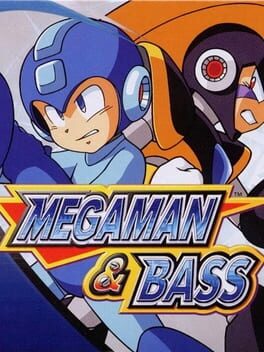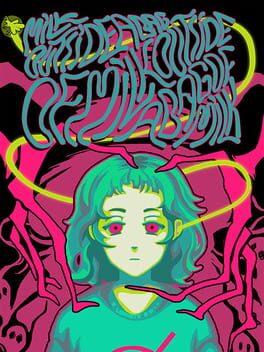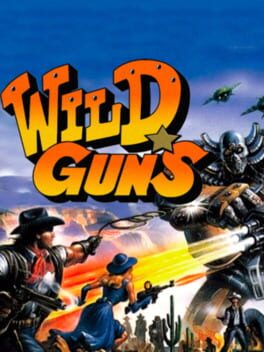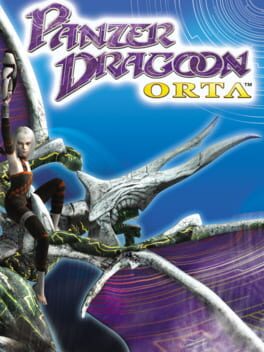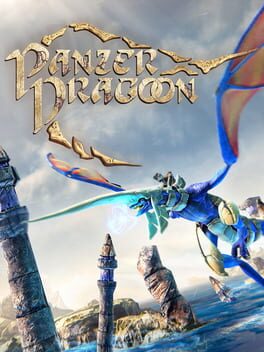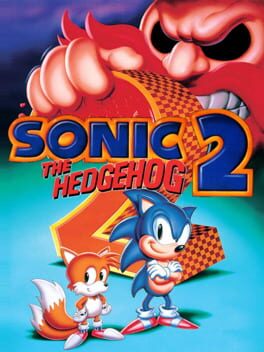OvisAries
2020
Oof, I thought I would love this one, but somehow I still think I had a better time with the original.
Gunvolt 2 is not a bad game, far from it, I just think there's something seriously backwards with the design of the Gunvolt series as a whole. Every game is piss easy to beat, but the challenge comes from getting high ranks. It makes for a miserable first experience in every stage, since one fuck up can ruin your score and any obstacle will require a lot of trial and error.
Is that inherently without value? No, as I said, this is not a bad game, but it's a game for a very specific kind of player that will want to put up with its insane demands just to see a shiny "S+" rating at the end.
Hey, sometimes it's good to lay the responsibility on the player, instead of making an unapproachable base difficulty (as I'm sure Inti couldn't stop hearing it with the Mega Man games they made). That said, is it satisfying to get through a level knowing that you botched most of it? And does it really feel that great to get a perfect score by purely memorizing every obstacle?
Gunvolt 2 is not a bad game, far from it, I just think there's something seriously backwards with the design of the Gunvolt series as a whole. Every game is piss easy to beat, but the challenge comes from getting high ranks. It makes for a miserable first experience in every stage, since one fuck up can ruin your score and any obstacle will require a lot of trial and error.
Is that inherently without value? No, as I said, this is not a bad game, but it's a game for a very specific kind of player that will want to put up with its insane demands just to see a shiny "S+" rating at the end.
Hey, sometimes it's good to lay the responsibility on the player, instead of making an unapproachable base difficulty (as I'm sure Inti couldn't stop hearing it with the Mega Man games they made). That said, is it satisfying to get through a level knowing that you botched most of it? And does it really feel that great to get a perfect score by purely memorizing every obstacle?
1986
2022
1991
1998
Bigger, more refined, but not as impactful as the first one.
Too coherent for its own good. Surprisingly, the first one was way more focused, if infinitely less coherent.
I do not want to undermine all the effort that surely went into it, but at the same time I can't shake the feeling that this game felt more preocupied with meeting expectations, and feels less genuine as a result.
Too coherent for its own good. Surprisingly, the first one was way more focused, if infinitely less coherent.
I do not want to undermine all the effort that surely went into it, but at the same time I can't shake the feeling that this game felt more preocupied with meeting expectations, and feels less genuine as a result.
1994
Nearly flawless.
It's the rare type of action game with the kind of charm that makes you stow any frustration and allow yourself simply enjoy it to the fullest.
I have some minor complaints, but they don't really detract from my rating. For once, I wish there was more of it. 6 stages is criminally short, but they're so sweet that I'm glad I even got to play them.
The game does a poor job at communicating the propper way to utilize all your tools. It took many, many deaths for me to realize the way to activate the Vulcan gun, and I didn't even know you could throw a lasso until I saw some playthroughs online. However, the unlimited continues means it's never too frustrating to die, so the time to experiment and figure things out is definitely there.
Lastly, I wish one of the shoulder buttons could have been used to recenter your crosshair. I'd often have to push myself to the edge of the screen just to realign my aim. In a game where positioning is essential, that was quite inconvenient. That said, I'm not entirely sure how a re-center button could have messed with the game's balance.
Anyway, if you like rail shooters, gallery shooters, arcade action or simply action games, there's absolutely no reason to skip Wild Guns.
It's the rare type of action game with the kind of charm that makes you stow any frustration and allow yourself simply enjoy it to the fullest.
I have some minor complaints, but they don't really detract from my rating. For once, I wish there was more of it. 6 stages is criminally short, but they're so sweet that I'm glad I even got to play them.
The game does a poor job at communicating the propper way to utilize all your tools. It took many, many deaths for me to realize the way to activate the Vulcan gun, and I didn't even know you could throw a lasso until I saw some playthroughs online. However, the unlimited continues means it's never too frustrating to die, so the time to experiment and figure things out is definitely there.
Lastly, I wish one of the shoulder buttons could have been used to recenter your crosshair. I'd often have to push myself to the edge of the screen just to realign my aim. In a game where positioning is essential, that was quite inconvenient. That said, I'm not entirely sure how a re-center button could have messed with the game's balance.
Anyway, if you like rail shooters, gallery shooters, arcade action or simply action games, there's absolutely no reason to skip Wild Guns.
2002
Poor Panzer Dragoon.
I only got into the series recently, and I've seen it has a dedicated fanbase, but between Saga and Orta, the Panzer Dragoon series is a strong contender for the most underrated game franchise ever. Orta alone puts rail-shooter classics like Star Fox 64 to shame, delivering both incredible gameplay and a universe to get lost in.
I only got into the series recently, and I've seen it has a dedicated fanbase, but between Saga and Orta, the Panzer Dragoon series is a strong contender for the most underrated game franchise ever. Orta alone puts rail-shooter classics like Star Fox 64 to shame, delivering both incredible gameplay and a universe to get lost in.
I'd been really curious about the Panzer Dragoon games for a while, and I had a very pleasent time with the game. That said, it was rather bland towards the end, as there was no real gameplay twist beyond the core mechanics introduced on the first episode.
For a game released before Star Fox 64, it's quite impressive. I love how dynamically it integrates the camera into its gameplay. It's an early 3D game and it seems to have gotten so much right the first time around. As a remake, however, I find it to be quite lacking in its camera use. The Saturn didn't have a second stick (or a stick at all for that matter), so using shoulder buttons to rotate the camera was the only option. What I don't understand is why the second stick couldn't be used for fine camera adjustments in this remake. The shoulder buttons could have still worked for 90° movements, but the lack of any option for fine adjustments makes it so you have some very awkward blind spots
That aside, although I find the core on-rails shooting more interesting than Star Fox 64's, that game offered much more varied objectives and modes of play. Panzer Dragoon has a very rigid structure that rarely deviates from itself. As a result, the game's climax doesn't feel all too different or more exciting than the rest of the game.
Anyway, I'll probably try Orta out some other day.
For a game released before Star Fox 64, it's quite impressive. I love how dynamically it integrates the camera into its gameplay. It's an early 3D game and it seems to have gotten so much right the first time around. As a remake, however, I find it to be quite lacking in its camera use. The Saturn didn't have a second stick (or a stick at all for that matter), so using shoulder buttons to rotate the camera was the only option. What I don't understand is why the second stick couldn't be used for fine camera adjustments in this remake. The shoulder buttons could have still worked for 90° movements, but the lack of any option for fine adjustments makes it so you have some very awkward blind spots
That aside, although I find the core on-rails shooting more interesting than Star Fox 64's, that game offered much more varied objectives and modes of play. Panzer Dragoon has a very rigid structure that rarely deviates from itself. As a result, the game's climax doesn't feel all too different or more exciting than the rest of the game.
Anyway, I'll probably try Orta out some other day.
2021
You know, Metroid Dread is great, even excellent. Mercury Steam really expanded upon the things they brought to the table with Samus Returns and then some. However, I hope they won't be the ones to keep making 2D Metroid in the future, because my biggest issue with Samus Returns is just as present in Dread, and that is the level design.
The crazy thing is, I don't see almost anyone talking about it as an issue. Some may point out the lack of exploration and its linearity, but I'd like to argue that the issue is larger than that.
Picture this: imagine you're knee deep into Super Metroid when suddenly, the map screen vanishes. Would you be able to figure your way around? I'd wager that yes, because each room/area is very distinct not only visually, but in shape and design. Few rooms feel alike. Now picture the same scenario while playing Dread. It could just be me, but I'd feel hopelessly lost without a map in that game. Dread's level design is not nearly distinct enough in a room to room basis, and most areas don't have a coherent structure to help orientate yourself.
Now, you may think it's not particularly fair to compare the two, as Dread's map is like 5 times the size of Super, but take for example Hollow Knight, with its massive map. Even after a year of first playing it, I can still picture in my head the way to the city of tears from greenpath, or how the forgotten crossroads connects to the many areas of the game. I just beat Dread yesterday, and I sure that in a week's time I will have forgoten how to get from Artaria to Burenia.
When I was first playing Samus Returns, I realized that the very first nut a Metroidvania has to crack to work is making a map that can be easily navigated even if there was no map screen, and both that game and Dread fail that test in my opinion. Each area is a marathon of winding corridors and crammed spaces with not very recognizable features or structure to them.
I think here's where the issue of level geometry and sense of direction comes into play. Take a look at any given room in Super Metroid and their shape will be easy to remember. They're mostly rectangles of varying sizes. That may sound boring to some, but it's made with the express intent of being easy to remember, because when you have to backtrack, you can easily picture an entire room in your head. Now, single rooms are one thing, but how you go from room, to room, to room is the other part of the story. Picture going from Brinstar to Norfair. The general direction is: you go down and right and you'll eventually get there. Of course it branches out, but the sense of direction is always clear, and it also opens up to other areas. If you go right and up, you can arrive at Crateria instead of Norfair.
Let's contrast this with Dread. First of, most rooms in Dread have very complex geometry. They wind in on themselves and have tucked away corners that makes it hard to remember their general shape. Many of them also branch out in multiple paths. If you enter Darion from Cataris and want to go to Burenia, your destination is technically just a straight line right to left, but the path there lacks a clear direction. Usually, any path from point A to point B in dread will make you go something like up, right, up again, left, down, left (still not there yet), down again, right, etc... As you can imagine, this also means there are a lot of dead ends and forks in the road that look like they connect but fall just short of it. The result of this design philosphy meant that, before going anywhere, I usually had to stare down the map screen for a good while and triple check I wouldn't just run into a dead end, which really destroyed the pace of the game. I'd say Burenia is probably the strongest area design-wise. Not only does it have distinct rooms with easy to remember shapes, it also has a completely vertical structure. This means that if you wanna get to a certain point you generally only have to go either up or down, regardless of how the area branches out.
To be fair, Super Metroid also has Maridia, an area with complex room structures and many winding paths that really obscure the way forward, but Super Metroid has arguably earned the right for such an area after the first two. I'm not sure if Dread does, as from beginning to end it has a very messy level structure.
Now, how can a game designer help a player through these kind of massive and complicated maps? Well, you limit the amount of options the player has to worry about by blocking certain paths. It generally wasn't hard to figure where to go in Dread, because it always felt very clear when the designers wanted me to move on, but I think they had to be so blatant in creating an obvious path forward because they created a very unbalanced map. There was no way in hell they could just drop you off and let you figure it out cuz most people would have grown frustrated, so they just made it a very guided experience.
This review has been quite negative so far, but I wanna stress that Metroid Dread does amazing things in other regards. It looks amazing, it sounds great and the fluidity of movement and combat is quite a step forward for the series (even if I'll never really get used to playing a 2D game with an analog stick), but as it's pretty clear by now, Dread dropped the ball in the most important thing, and that is its world.
It's actually quite sad to see modern Metroid struggle with something indies understand so well THANKS to Metroid...
The crazy thing is, I don't see almost anyone talking about it as an issue. Some may point out the lack of exploration and its linearity, but I'd like to argue that the issue is larger than that.
Picture this: imagine you're knee deep into Super Metroid when suddenly, the map screen vanishes. Would you be able to figure your way around? I'd wager that yes, because each room/area is very distinct not only visually, but in shape and design. Few rooms feel alike. Now picture the same scenario while playing Dread. It could just be me, but I'd feel hopelessly lost without a map in that game. Dread's level design is not nearly distinct enough in a room to room basis, and most areas don't have a coherent structure to help orientate yourself.
Now, you may think it's not particularly fair to compare the two, as Dread's map is like 5 times the size of Super, but take for example Hollow Knight, with its massive map. Even after a year of first playing it, I can still picture in my head the way to the city of tears from greenpath, or how the forgotten crossroads connects to the many areas of the game. I just beat Dread yesterday, and I sure that in a week's time I will have forgoten how to get from Artaria to Burenia.
When I was first playing Samus Returns, I realized that the very first nut a Metroidvania has to crack to work is making a map that can be easily navigated even if there was no map screen, and both that game and Dread fail that test in my opinion. Each area is a marathon of winding corridors and crammed spaces with not very recognizable features or structure to them.
I think here's where the issue of level geometry and sense of direction comes into play. Take a look at any given room in Super Metroid and their shape will be easy to remember. They're mostly rectangles of varying sizes. That may sound boring to some, but it's made with the express intent of being easy to remember, because when you have to backtrack, you can easily picture an entire room in your head. Now, single rooms are one thing, but how you go from room, to room, to room is the other part of the story. Picture going from Brinstar to Norfair. The general direction is: you go down and right and you'll eventually get there. Of course it branches out, but the sense of direction is always clear, and it also opens up to other areas. If you go right and up, you can arrive at Crateria instead of Norfair.
Let's contrast this with Dread. First of, most rooms in Dread have very complex geometry. They wind in on themselves and have tucked away corners that makes it hard to remember their general shape. Many of them also branch out in multiple paths. If you enter Darion from Cataris and want to go to Burenia, your destination is technically just a straight line right to left, but the path there lacks a clear direction. Usually, any path from point A to point B in dread will make you go something like up, right, up again, left, down, left (still not there yet), down again, right, etc... As you can imagine, this also means there are a lot of dead ends and forks in the road that look like they connect but fall just short of it. The result of this design philosphy meant that, before going anywhere, I usually had to stare down the map screen for a good while and triple check I wouldn't just run into a dead end, which really destroyed the pace of the game. I'd say Burenia is probably the strongest area design-wise. Not only does it have distinct rooms with easy to remember shapes, it also has a completely vertical structure. This means that if you wanna get to a certain point you generally only have to go either up or down, regardless of how the area branches out.
To be fair, Super Metroid also has Maridia, an area with complex room structures and many winding paths that really obscure the way forward, but Super Metroid has arguably earned the right for such an area after the first two. I'm not sure if Dread does, as from beginning to end it has a very messy level structure.
Now, how can a game designer help a player through these kind of massive and complicated maps? Well, you limit the amount of options the player has to worry about by blocking certain paths. It generally wasn't hard to figure where to go in Dread, because it always felt very clear when the designers wanted me to move on, but I think they had to be so blatant in creating an obvious path forward because they created a very unbalanced map. There was no way in hell they could just drop you off and let you figure it out cuz most people would have grown frustrated, so they just made it a very guided experience.
This review has been quite negative so far, but I wanna stress that Metroid Dread does amazing things in other regards. It looks amazing, it sounds great and the fluidity of movement and combat is quite a step forward for the series (even if I'll never really get used to playing a 2D game with an analog stick), but as it's pretty clear by now, Dread dropped the ball in the most important thing, and that is its world.
It's actually quite sad to see modern Metroid struggle with something indies understand so well THANKS to Metroid...
1992
1991
Playing this game is like being stuck in a doomed relationship.
Somehow, I keep falling for its bullshit every step of the way, even when I should see it coming. Despite all, I always find it in me to forgive it, thinking that we can still make it work; maybe with enough love and hope we can get back to the wonderful feelings we had for each other at the beginning. How foolish... Some way or another, Sonic the Hedgehog will find a way to screw it up.
Thank god for the rewind feature in the Sega Genesis Classics collection, otherwise Idk if I would have gone all the way through with it.
Now if only I could rewind my real life doomed relationship :'-(
Somehow, I keep falling for its bullshit every step of the way, even when I should see it coming. Despite all, I always find it in me to forgive it, thinking that we can still make it work; maybe with enough love and hope we can get back to the wonderful feelings we had for each other at the beginning. How foolish... Some way or another, Sonic the Hedgehog will find a way to screw it up.
Thank god for the rewind feature in the Sega Genesis Classics collection, otherwise Idk if I would have gone all the way through with it.
Now if only I could rewind my real life doomed relationship :'-(
2021
Steel Assault's biggest crime is being too short. What's actually there is brilliant, but it sorta blows its load before one feels satisfied. In other words, it's a very sweet experience, but it lacks nuance.
I think the issue could have been solved had it had 2 more chapters at least, cuz as it currently stands, the narrative's very underwhelming. The climax doesn't feel too impactful because it's not built up to effectively. Of course, the game's arcadey nature doesn't call for an epic narrative, but the issue affects gameplay too. All the game's mechanics are beautiful, but some feel underutilized. The tone of the action doesn't shift enough as things go on.
Compare Steel Assault to Alien Soldier (a game it CERTAINLY drew a lot from). In AS, my boy Epsilon Eagle gets a million things done and goes from here to there, gameplay constantly shifting while keeping all core mechanics intact, all in a similar completion length. In contrast, Steel Assault doesn't seem to have the confidence to experiment with the mechanical complexity it already has. Now, it's unfair to ask it to stack up to mf Alien Soldier, but if it had to be such a short experience, it would have been good to make the most of it.
Anyway, I don'y wanna be too negative. The game's a total blast and any 2D action fan would do good to check it out. Normal mode's a push over, so Expert mode's where it's at.
I think the issue could have been solved had it had 2 more chapters at least, cuz as it currently stands, the narrative's very underwhelming. The climax doesn't feel too impactful because it's not built up to effectively. Of course, the game's arcadey nature doesn't call for an epic narrative, but the issue affects gameplay too. All the game's mechanics are beautiful, but some feel underutilized. The tone of the action doesn't shift enough as things go on.
Compare Steel Assault to Alien Soldier (a game it CERTAINLY drew a lot from). In AS, my boy Epsilon Eagle gets a million things done and goes from here to there, gameplay constantly shifting while keeping all core mechanics intact, all in a similar completion length. In contrast, Steel Assault doesn't seem to have the confidence to experiment with the mechanical complexity it already has. Now, it's unfair to ask it to stack up to mf Alien Soldier, but if it had to be such a short experience, it would have been good to make the most of it.
Anyway, I don'y wanna be too negative. The game's a total blast and any 2D action fan would do good to check it out. Normal mode's a push over, so Expert mode's where it's at.

